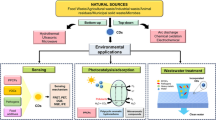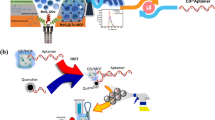Abstract
Novel Co(OH)2/MXene-Ti3C2 nanocomposites with oxidase (OXD)-mimic, peroxidase (POD)-mimic, and catalase (CAT)-mimic activities were prepared by a simple two-step method. The Co(OH)2/MXene-Ti3C2 nanocomposites with triple-enzyme mimic activities were embedded into sodium alginate (SA) gels for the first time to fabricate a target-responsive hydrogel-assisted assay. The catalytic mechanism and steady-state kinetics of Co(OH)2/MXene-Ti3C2 nanocomposites were investigated. Subsequently, hypoxanthine (Hx) was catalyzed by xanthine oxidase (XOD) to form H2O2, which reacts with 3,3′,5,5′-tetramethyl-benzidine (TMB) in the presence of Co(OH)2/MXene-Ti3C2 nanocomposites to form a blue oxide (ox-TMB) in the hydrogel. The visible color change of the hydrogel with the increase of Hx concentration can be recognized through a smartphone App to transfer the red (R), green (G), and blue (B) values for the quantitative determination of Hx, with a detection range from 5 to 250 μM, and detection limit of 0.2 μM. The method was applied to the determination of Hx content in different aquatic products. The spiked recoveries of the aquatic products were from 94.1 to 106.4%, and the relative standard deviations (RSD) were less than 5.4%. Our results show that the Co(OH)2/MXene-Ti3C2 nanocomposites hydrogel-assisted colorimetric biosensor is cost-effective, sensitive, and selective and has excellent application prospects for in-the-field determination of Hx.
Graphical abstract







Similar content being viewed by others
References
Liang X, Han L (2020) White peroxidase-mimicking nanozymes: colorimetric pesticide assay without interferences of O2 and color. Adv Funct Mater 30:2070184. https://doi.org/10.1002/adfm.202001933
Gao L, Zhuang J, Nie L, Zhang JN, Gu N, Wang T et al (2007) Intrinsic peroxidase-like activity of ferromagnetic nanoparticles. Nat. Nanotechnol 2:577–583. https://doi.org/10.1038/nnano.2007.260
Gumpelmayer M, Nguyen M, Molnar G, Bousseksou A et al (2018) Magnetite Fe3O4 has no intrinsic peroxidase activity, and is probably not involved in Alzheimer’s oxidative stress. Angew Chem Int Ed 57:14758–14763. https://doi.org/10.1002/ange.201807676
Wang MG, Yang WJ, Li XZ, Xu YS, Zheng L et al (2021) Atomically dispersed Fe-heteroatom (N, S) bridge sites anchored on carbon nanosheets for promoting oxygen reduction reaction. ACS Energy Lett 6:379–386. https://doi.org/10.1021/acsenergylett.0c02484
Guo X, Yang F, Jing L (2022) In-situ generation of highly active and four-in-one Cofe2o4/H2 ppop nanozyme: mechanism and its application for fast colorimetric detection of Cr (Vi). Mech Eng J 431:128621. https://doi.org/10.1016/j.jhazmat.2022.128621
Sun MM, He MX, Jiang SJ, Wang YY, Wang XX, Liu T, Song C et al (2021) Multi-enzyme activity of three layers FeOx@ZnMnFeOy@Fe-Mn organogel for colorimetric detection of antioxidants and norfloxacin with smartphone. Chem Eng J 425:131823. https://doi.org/10.1016/j.cej.2021.131823
Fathirad F, Mostafavi A, Afzali D (2016) Electrospun Pd nanoparticles loaded on Vulcan carbon/ conductive polymeric ionic liquid nanofibers for selective and sensitive determination of tramadol. Analytica Chimica Acta 940:65–72. https://doi.org/10.1016/j.aca.2016.08.051
Afzali D, Rouhani M, Fathirad F et al (2016) Nano-iron oxide coated on sand as a new sorbent for removal of arsenic from drinking water. Desalin Water Treat 57:13030–13037. https://doi.org/10.1080/19443994.2015.1054890
Afzali D, Bahadori B, Fathirad F (2013) Ultrasound-assisted emulsification/microextraction based on solidification of trace amounts of thallium prior to graphite furnace atomic absorption spectrometry determination. Toxicol Environ Chem 95:1080–1089. https://doi.org/10.1080/02772248.2013.856912
Ghanbarian M, Afzali D, Mostafavi A et al (2013) Displacement-dispersive liquid–liquid microextraction based on solidification of floating organic drop of trace amounts of palladium in water and road dust samples prior to graphite furnace atomic absorption spectrometry determination. J AOAC Int 96:880–886. https://doi.org/10.5740/jaoacint.11-495
Li MM, Peng XY, Han YJ, Guo YJ et al (2021) Ti3C2 MXenes with intrinsic peroxidase-like activity for label-free and colorimetric sensing of proteins-Science Direct. Microchem J 166:106238. https://doi.org/10.1016/j.microc.2021.106238
Shin H, Eom W, Lee KH, Jeong W, Han TH et al (2021) Highly electroconductive and mechanically strong Ti3C2Tx MXene fibers using a deformable MXene Gel. ACS Nano 15:3320–3329. https://doi.org/10.1021/acsnano.0c10255
Wu XJ, Chen TM, Chen Y, G. W. Yang G W, et al (2020) Modified Ti3C2 nanosheets as peroxidase mimetics for use in colorimetric detection and immunoassays. J Mater Chem B 8:2650–2659. https://doi.org/10.1039/D0TB00239A
Li YP, Kang ZW, Kong LY, Shi HT, Yang DP et al (2019) MXene-Ti3C2/CuS nanocomposites: enhanced peroxidase-like activity and sensitive colorimetric cholesterol detection. Mater Sci Eng C 104:110000. https://doi.org/10.1016/j.msec.2019.110000
Shi Y, Liu Z, Liu R (2022) DNA-encoded MXene-Pt nanozyme for enhanced colorimetric sensing of mercury ions. Chem Eng J 442:136072. https://doi.org/10.1016/j.cej.2022.136072
Ziaadini F, Mostafavi A, Shamspur T et al (2019) Photocatalytic degradation of methylene blue from aqueous solution using Fe3O4@ SiO2@ CeO2 core-shell magnetic nanostructure as an effective catalyst. Adv Environ Technol 5:127–132. https://doi.org/10.22104/AET.2020.4137.1204
Afzali D, Fathirad F, Ghaseminezhad S et al (2014) Determination of trace amounts of zirconium in real samples after microwave digestion and ternary complex dispersive liquid–liquid microextraction. Environ Monit Assess 186:3523–3529. https://doi.org/10.1007/s10661-014-3635-7
Afzali D, Padash M, Fathirad F et al (2015) Determination of trace amounts of antimony (III) based on differential pulse voltammetric method with multi-walled carbon-nanotube -modified carbon paste electrode. Ionics 21:565–570. https://doi.org/10.1007/s11581-014-1200-6
Chen ZT, Lin Y, Ma XM, Chen GN, Lin ZY et al (2017) Multicolor biosensor for fish freshness assessment with the naked eye. Sens Actuators B Chem 252:201–208. https://doi.org/10.1016/j.snb.2017.06.007
Mustafa F, Andreescu S (2020) Paper-based enzyme biosensor for one-step detection of hypoxanthine in fresh and degraded fish. ACS Sensors 5:4092–4100. https://doi.org/10.1021/acssensors.0c02350
Rong SZ, Zou LN, Zhang YZ, Zhang GT, Yang FH et al (2015) Determination of purine contents in different parts of pork and beef by high performance liquid chromatography. Food Chem 170:303–307. https://doi.org/10.1016/j.foodchem.2014.08.059
Yoo BC, Kong SY, Jang SG, Park WS et al (2010) Identification of hypoxanthine as a urine marker for non-Hodgkin lymphoma by low-mass-ion profiling. BMC Cancer 55:5835. https://doi.org/10.1186/1471-2407-10-55
Caussé E, Pradelles A, Dirat B, Anne NS, Salvayre R, Couderc F et al (2010) Simultaneous determination of allantoin, hypoxanthine, xanthine, and uric acid in serum/plasma by CE. Electrophoresis 28:381–387. https://doi.org/10.1002/elps.200600205
Mustafa F, Othman A, Andreescu S (2021) Cerium oxide-based hypoxanthine biosensor for fish spoilage monitoring-science direct. Sens Actuators B Chem 332:129435. https://doi.org/10.1016/j.snb.2021.129435
Cheng H, Zhang L, He J (2016) Integrated nanozymes with nanoscale proximity for in vivo neurochemical monitoring in living brains. Anal Chem 88:5489–5497. https://doi.org/10.1021/acs.analchem.6b00975
Pal K, Banthia AK, Majumdar DK (2009) Polymeric hydrogels: characterization and biomedical applications. Des Monomers Polym 12:197–220. https://doi.org/10.1016/j.biomaterials.2009.12.052
Ogura K, Rehm BHA (2019) Alginate encapsulation of bioengineered protein-coated polyhydroxybutyrate particles: a new platform for multifunctional composite materials. Adv Funct Mater 29:1901893. https://doi.org/10.1002/adfm.201901893
Deng DY, Xing XX, Chen N, Li YX, Wang YD et al (2017) Hydrothermal synthesis of β-Co(OH)2 nanoplatelets: a novel catalyst for CO oxidation. J Phys Chem Solids 100:107–114. https://doi.org/10.1016/j.jpcs.2016.09.021
Jiang HM, Wang ZG, Dong LC, Dong MD et al (2020) Co(OH)2/MXene composites for tunable pseudo-capacitance energy storage. Electrochim. Acta. 353:136607
Niu XH, Shi QR, Zhu WL, Fu SF, Cheng N et al (2019) Unprecedented peroxidase-mimicking activity of single-atom nanozyme with atomically dispersed Fe-Nx moieties hosted by MOF derived porous carbon-Science Direct. Biosens Bioelectron 142:111495. https://doi.org/10.1016/j.bios.2019.111495
Liu L, Sun C, Yang J, Shi Y, Long Y, Zheng H et al (2018) Fluorescein as a visible-light-induced oxidase mimic for signal-amplified colorimetric assay of carboxylesterase by enzymatic cascade reaction. Chem Eur J 24:6148–6154. https://doi.org/10.1002/chem.201705980
Funding
This work was financially supported by the National Natural Science Foundation of China (21707030 and 82073608).
Author information
Authors and Affiliations
Corresponding authors
Ethics declarations
Competing interests
The authors declare no competing interests.
Additional information
Publisher's note
Springer Nature remains neutral with regard to jurisdictional claims in published maps and institutional affiliations.
Supplementary information
Below is the link to the electronic supplementary material.
Rights and permissions
Springer Nature or its licensor (e.g. a society or other partner) holds exclusive rights to this article under a publishing agreement with the author(s) or other rightsholder(s); author self-archiving of the accepted manuscript version of this article is solely governed by the terms of such publishing agreement and applicable law.
About this article
Cite this article
Yang, Q., Qin, Y., Lei, T. et al. Co(OH)2/MXene-Ti3C2 nanocomposites with triple-enzyme mimic activities as hydrogel sensing platform for on-site detection of hypoxanthine. Microchim Acta 189, 481 (2022). https://doi.org/10.1007/s00604-022-05584-z
Received:
Accepted:
Published:
DOI: https://doi.org/10.1007/s00604-022-05584-z




